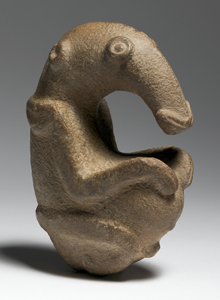Pacific art

Papua New Guinea, Western Highlands, Ambum Valley 'The Ambum stone' c.1500 BCE, greywacke stone, purchased 1977, collection of the National Gallery of Australia click to see more
Introduction
The National Gallery of Australia has collected art from Australia’s Pacific neighbours since 1969 in order to display historical traditional objects from the Pacific as art rather than artefact. The collection spans one-third of the world’s surface, encompassing Melanesia, Micronesia and Polynesia with myriad cultures stretching from Papua New Guinea to New Zealand and Easter Island. It also ranges in scope from 3500 BCE to the present day.
For much of the nineteenth and twentieth centuries, museums have predominantly exhibited beautiful works by Pacific artists to represent Pacific communities from a western anthropological viewpoint. The objects have rarely been displayed as artworks with universal appeal and great visual force. The Gallery’s collection of Pacific arts was guided by the keen eye of Sir William Dargie and later James Mollison, Douglas Newton and Ruth McNicoll, all of whom made astute additions to the collection of some of the finest works from the Pacific.
One of the strengths is the Dargie field collection from Bismarck Archipelago and the Sepik River of Papua New Guinea. Other core areas include a strong selection of eighteenth- and nineteenth-century Maori art, the Charpentier collection from Vanuatu, and single works of great importance such as the prehistoric Ambum stone and the Lake Sentani double figure collected by Jacque Viot in 1929.
